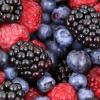Pollen, propolis, royal jelly, and honey all show some effect on dementia and depression. An interesting property bee pollen shares with broccoli sprouts is anti-autism. Chrysin, a component of bee pollen, has been studied for its anti-anxiety effects... it seems to work through GABA agonism, so to avoid long-term desensitization, you're going to want to pair it off with an antagonist such as ginkgo[1] or ginseng[2]. There is also an Arabic study directly on bee pollen and anxiety[3].
Royal jelly boosts testosterone (oops, meant to save that for later) while both bee pollen and royal jelly have potential in menopause[4] and prostate health (click the first study). Since hot flashes can affect your concentration, that's brain health.
It's my belief these substances, used moderately, have a generally favorable effect on hormonal status (particularly the R.J. and pollen). You learned they affect testosterone and estrogen already, later you will see propolis affects glucocorticoid receptors. What's not included here, as well, is a discussion of the effects on endocrine regulation and chronic mild stress. A lot of this doesn't appear on examine.com: the GDNF, the anti-autism, the propolis, the endorcrine bit, or the specific depression studies (see the first and third quote blocks).
Bee Pollen: Chemical Composition and Therapeutic Application
Katarzyna Komosinska-Vassev, Pawel Olczyk, Lukasz Mencner, and Krystyna Olczyk (2015)
Pollen, administered alongside antidepressants, enables the lowering of their doses and improves the overall condition in a short period of time.
Owing to its nutritional and tonic properties as well as improvement of blood supply to nervous tissue, pollen boosts mental capacity and strengthens the nervous system weakened by stress or overworking [48–50]. Therefore, pollen is effective in treating physical and mental overtiredness, asthenia, and apathy.
48. Wójcicki J. The influence of pollen extracts on biochemical disturbances in rats exposed to prolonged ethyl alcohol intake
. Herba Polonica. 1989;35:p. 201.
49. Wojcicki J., Samochowiec L., Hinek A. The effect of cernitins on galactosamine-induced hepatic injury in rat. Archivum Immunologiae et Therapiae Experimentalis. 1985;33(2):361–370. [PubMed]
50. Wójcicki J. The effect of pollen extracts on the endocrine function in rabbits. Herba Polonica. 1991;27:p. 151.
Therapeutic potency of bee pollen against biochemical autistic features induced through acute and sub-acute neurotoxicity of orally administered propionic acid
Huda S. Al-Salem, Ramesa Shafi Bhat, Laila Al-Ayadhi, and Afaf El-Ansary (2016)
Background: It is now well documented that postnatal exposure to certain chemicals has been reported to increase the risk of autism spectrum disorder. Propionic acid (PA), as a metabolic product of gut microbiotaandas a commonly used food additive, has been reported to mediate the effects of autism. Results from animal studies may help to identify environmental neurotoxic agents and drugs that can ameliorate neurotoxicity and may thereby aid in the treatment of autism. The present study investigated the ameliorative effects of natural bee pollen against acute and sub-acute brain intoxication induced by (PA) in rats.
Methods: Twenty-four young male Western Albino ratswere enrolled in the present study. They were classified into four equal groups, eachwith6 rats. The control group received only phosphate buffered saline; the oral buffered PA-treated groups (II and III) received a neurotoxic dose of 750 mg/kg body weight divided in 3 dose of 250 mg/kg body weight/day serving asthe acute group and 750 mg/kg body weight divided in 10 equal dose of 75 mg/kg body weight/day as the sub-acute group. The fourth group received 50 mg bee pollen for 30 days after PA-acute intoxication.
Results: The obtained data showed that the PA-treated groups demonstrated multiple signs of brain toxicity, as indicated by a depletion of serotonin (5HT), dopamine and nor-adrenaline, together withan increase in IFN-γ and caspase 3. Bee pollen was effective in ameliorating the neurotoxic effect of PA. All measured parameters demonstrated minimal alteration in comparison with thecontrol animal than did those of acute and sub-acute PA-treated animals.
Conclusions: In conclusion, bee pollen demonstrates anti-inflammatory and anti-apoptotic effects while ameliorating the impaired neurochemistry of PA-intoxicated rats.
Evaluation of the anxiolytic effects of chrysin, a Passiflora incarnata extract, in the laboratory rat.
Brown E'1, Hurd NS, McCall S, Ceremuga TE. (2007)
The definitive anxiolytic effects of Passiflora incarnata are unknown. We studied the potential anxiolytic effects of chrysin, a Passiflora extract, and the purported modulation of the benzodiazepine receptor on the GABA(A) receptor in laboratory rats. We hypothesized that chrysin decreases anxiety via interaction with the GABA(A) receptor in laboratory rats as measured by elevated plus-maze (EPM), corticosterone, and catecholamine assays. We randomized 44 male Sprague-Dawley rats in a double-blind, placebo-controlled, between-subjects experimental design. Each animal received an intraperitoneal injection of (1) vehicle (DMSO 4%), (2) chrysin, 2 mg/kg, (3) midazolam, 1.5 mg/kg, or (4) flumazenil, 3 mg/kg and chrysin, 2 mg/kg. The EPM was used to evaluate the behavioral component of anxiolysis, and catecholamine and corticosterone assays were examined to measure the neurohormonal effects of anxiety. No statistical difference was found among groups in catecholamine and corticosterone levels. Midazolam significantly decreased anxiety compared with control and flumazenil plus chrysin groups (P <.05); there was no significant difference compared with the chrysin group. These data suggest that chrysin may have anxiolytic properties similar to midazolam but to a lesser magnitude at the 2 mg/kg dose used in this study.
Propolis has interesting antidepressive-glucocorticoid effects, however excessive consumption may result in memory loss or psychosis[!]. Glucocorticoid and adrenoreceptors are highly hormonal, involved in the HTPA, and affect everything from dopamine to oxytocin[5].
Novel Antidepressant-Like Activity of Propolis Extract Mediated by Enhanced Glucocorticoid Receptor Function in the Hippocampus
Mi-Sook Lee, Young Han Kim, Wan-Soon Park (2013)
Propolis is a natural product made by honeybees that has been widely used in folk medicine with a broad spectrum of biological activities. To investigate the antidepressant-like activity of propolis extract, CD-1 mice were administered an ethanol extract of propolis (50, 100, or 200 mg/kg, p.o.) prior to the behavioral test. The propolis extract-treated group showed a dose-dependent decrease in immobility time in the FST and tail suspension test without altering locomotor activity. Propolis extract decreased the limbic hypothalamic-pituitary-adrenal axis (HTPA) response to the FST as indicated by an attenuated corticosterone response and decreased in c-fos immunoreactive neurons in the hippocampal dentate gyrus. Western blot analysis revealed a reduction in hippocampal glucocorticoid receptor (GR) expression following the FST, which was reversed by propolis extract. Propolis extract also increased pGR(S220)/(S234) ratio by a differential phosphorylation in S220 and S234. FST-induced downregulation of cAMP-responsive element binding protein phosphorylation at S133 (pCREB) was restored by propolis extract, showing a strong and positive relationship between pCREB and pGR(S220)/(S234) ratio. These findings suggest that the propolis extract potentiates antidepressant-like activity by enhancing GR function which is one of the therapeutic mechanisms of antidepressant; thus, propolis extract may provide a novel therapy for depression.
Royal jelly, or worker bee vomit fed to the queen and larvae, also has promising effects. It improves memory of aged rats (see bottom study), it protects against models of depression and dementia (see bullet points), and to top it all off, it induces 17β-HSD3 (therefore promoting testosterone production and brain health.. see indented bullet). Royal jelly shows potential potential for mental health, diabetes, and conditions involving low red blood cell count. You might think wow that's a lot, he's been really thorough in his research.. but sadly I've only scratched the surface.
- In a stress-inducible depression-like mouse model, 10-hydroxy-trans-2-decenoic acid, an unsaturated fatty acid unique to RJ, protected against depression and anxiety [30].
- One of unique components in RJ is 10-hydroxy-trans-2decanoic acid (HDEA), an unsaturated fatty acid. Because HDEA is a small unsaturated fatty acid, it can pass through blood–brain barrier. It has been demonstrated that HDEA mimics the effects of brain-derived neurotrophic factor (BDNF) and probably stimulate neurogenesis in the mature brain.[20]
- In the present trial, less increase in DHEA-S and more increase in T in the RJ group than in the control one was observed, suggesting that RJ may have induced the conversion of DHEA to Testosterone by stimulating 3β-HSD2 and/or 17β-HSD3 as shown in Figure 2.
With Royal Jelly, in addition to testosterone boosting and memory enhancing effects in old rats, there is evidence of bidirectional modulation on dopamine and serotonin, a property which it shares with reserpine[6], an alkaloid of Indian Snake Root. It also has promising effects on GDNF and Parkinson's models. While the outcome looks good, further studies are needed to evaluate benefits in young, and especially mentally ill volunteers.
Long-term administration of Greek Royal Jelly improves spatial memory and influences the concentration of brain neurotransmitters in naturally aged Wistar male rats.
Pyrzanowska J1, Piechal A1, Blecharz-Klin K1, Joniec-Maciejak I1, Graikou K2, Chinou I2, Widy-Tyszkiewicz E3. (2014)
ETHNOPHARMACOLOGICAL RELEVANCE: Royal Jelly (RJ) is a bee-derived product that has been traditionally used in the European and Asian systems of medicine for longevity. RJ has various pharmacological activities that may prevent aging e.g., anti-inflammatory, anti-oxidative, anti-hypercholesterolemic and anti-hyperglycemic properties.
AIM OF THE STUDY: To evaluate the behavioral and neurochemical effects of long-term oral, previously chemically analyzed, Greek RJ administration to aged rats.
MATERIALS AND METHODS: RJ powder was given to 18-month old male Wistar rats (50 and 100mg of powder/kg b.w./day) by gastric gavage for 2 months. The spatial memory was assessed in the water maze and next the level of neurotransmitters, their metabolites and utilization in the selected brain regions were estimated.
RESULTS: The improvement of memory in rats pretreated with the smaller dose of RJ was observed compared with controls. In biochemical examination mainly the depletion of dopamine and serotonin in the prefrontal cortex along with an increase in their metabolite concentration and turnover were seen.
CONCLUSION: Better cognitive performance in the old animals using a non-toxic, natural food product in the view of the process of the aging of human population is noteworthy. Our results contribute towards validation of the traditional use of RJ in promoting a better quality of life in old age.
Oral administration of royal jelly facilitates mRNA expression of glial cell line-derived neurotrophic factor (GDNF) and neurofilament H in the hippocampus of the adult mouse brain.
Hashimoto M1, Kanda M, Ikeno K, Hayashi Y, Nakamura T, Ogawa Y, Fukumitsu H, Nomoto H, Furukawa S. (2005)
Royal jelly (RJ) is known to have a variety of biological activities toward various types of cells and tissues of animal models, but nothing is known about its effect on brain functions. Hence, we examined the effect of oral administration of RJ on the mRNA expression of various neurotrophic factors, their receptors, and neural cell markers in the mouse brain. Our results revealed that RJ selectively facilitates the mRNA expression of glial cell line-derived neurotrophic factor (GDNF), a potent neurotrophic factor acting in the brain, and neurofilament H, a specific marker predominantly found in neuronal axons, in the adult mouse hippocampus. These observations suggest that RJ shows neurotrophic effects on the mature brain via stimulation of GDNF production, and that enhanced expression of neurofilament H mRNA is involved in events subsequently caused by GDNF. RJ may play neurotrophic and/or neuroprotective roles in the adult brain through GDNF.
![]()

























































